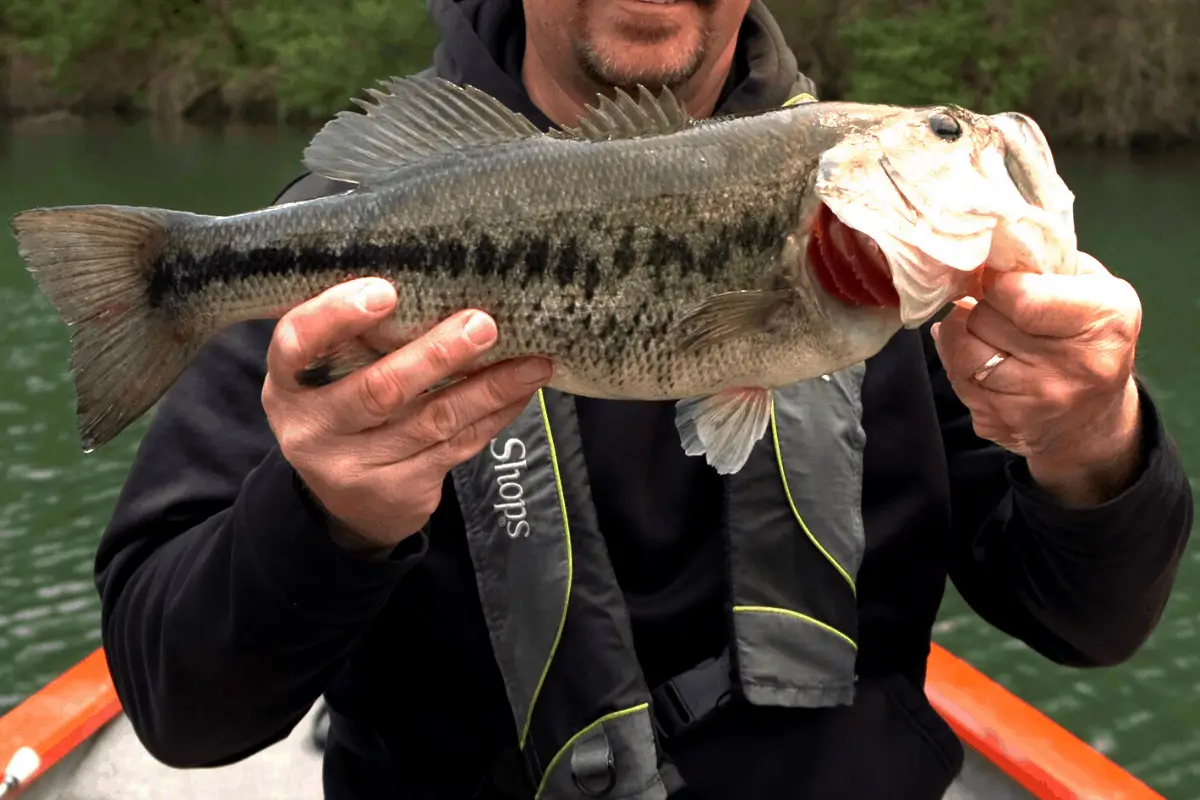After the bass finish spawning, finding them can be quite the challenge. These tried-and-true tactics will put anglers in high percentage places to keep the bite going.
To find bass in the post-spawn anglers need to think about how-and-where bass travel from the spawning flats back to summer hangouts. Targeting structure, like secondary points, can be a great starting place. The bass will be seeking deeper water. Using lures that can cover the depths are popular choices during this transition time.
In this article, I will discuss all aspects of the post-spawn and how anglers can keep putting themselves in high percentage areas.
What is the Post-Spawn?
The days and even weeks immediately following the spawning season are considered the post-spawn. True summer patterns are still yet to happen and bass can hang in post-spawn transition zones for longer than most of us expect.
Once bass move shallow and spawn they are usually done in just a few days.
The males will hang around and guard the fry for a while, but eventually, they will leave the youngsters to fend for themselves.
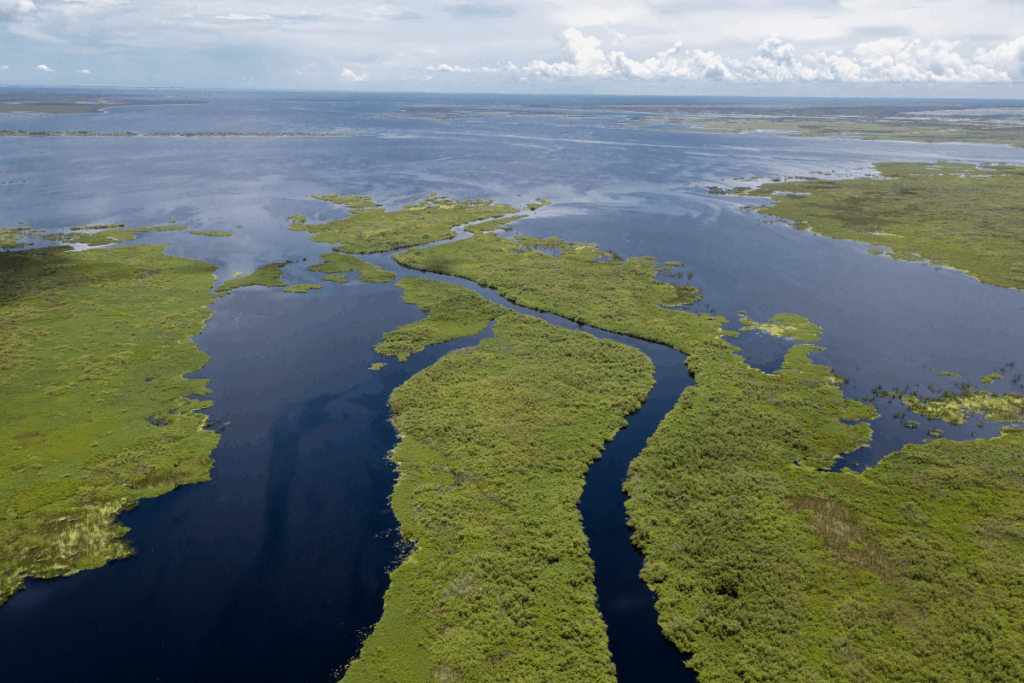
Post-Spawn Migration Routes
Bass use migration routes in the pre-spawn. They do the same thing in the post-spawn, albeit, not always the same way.
To start the search, look for traditional spawning areas. These include large flats in the backs of coves and pockets.
When the bass leave the beds they are going to seek deeper water. In some instances, they may move from 2ft of water to 3ft. Other times they may make a more drastic move hitting the double digits zone right after leaving the spawning area.
So how are they located?
First, take a look at a map or satellite image of the water you are fishing. Pinpoint the spawning flat. Then locate main lake or river structure. A primary point or the edge of an old creek channel are typical examples.
Now think about what route the bass are likely to take from one to the other.
Are there secondary points along the way? Is there a rip-rap causeway? Can you find some brush piles, docks, or boulders?
Locating places where the bass feel safe and can hang out is the primary objective.
If you can find where two types of cover or structure intersect that is even better. Maybe there is a beaver hut in the middle of a lily pad field or you may find a dock sitting on a secondary point.
The Bass Are Schooling Up Again During the Post-Spawn
In the prespawn, it is not uncommon to find bass in schools as they prepare to move shallow.
During the spawn, the males and females partner up and spread out.
Once the spawn is over, these staging areas can hold groups of fish as they slowly move out to summer locations.
You may fish several likely areas without a bite. Then you hit one where you get bit right away. Stick with that location for a few more casts. There may be several fish stacked upon it.
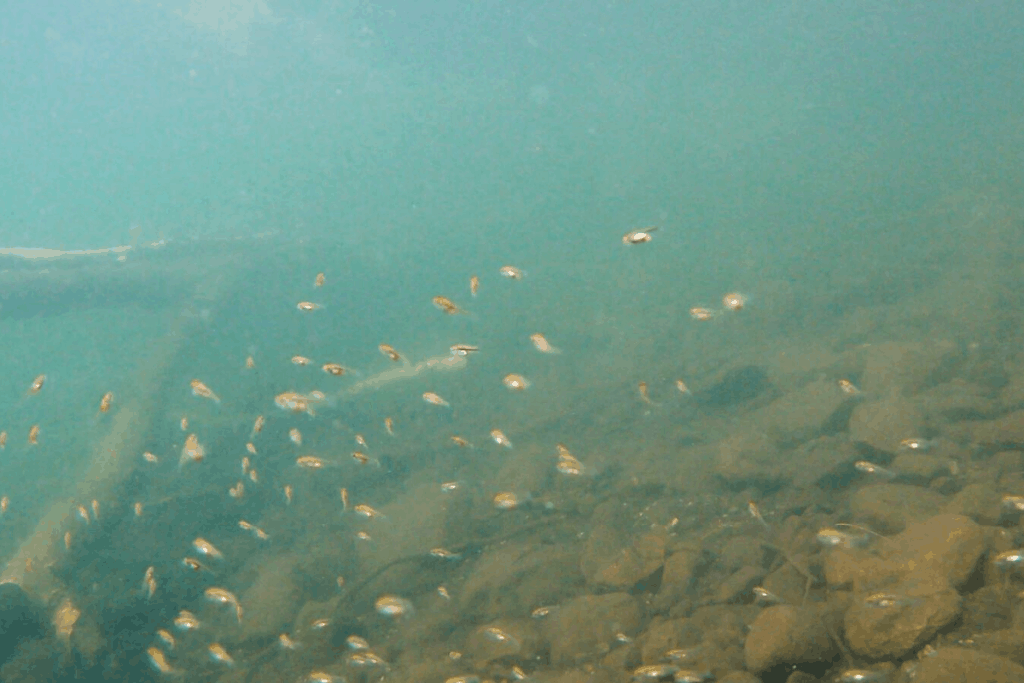
Fry Guarding
If your lure gets hammered immediately, there is a good chance that a male bass is guarding some fry. Those fish will often hit again. It is not unusual to catch the same fish twice when they are in full protection mode of the little ones.
Where there is one small school of fry, there are usually others. Scour the area and keep an open eye out for what looks like a little black cloud rotating in the water. The male bass will not be far from them.
Just be sure to put that male bass back quickly so they can continue to watch over the brood. Hungry bluegills love to make a snack out of baby bass.
Post-Spawn Lures
The name-of-the-game in the post-spawn is to cover water. There is a lot of searching that needs to happen to locate those resting points.
Once fish are located, an angler can change lures if needed to soak an area thoroughly, but until then choosing a lure and technique that keeps the trolling motor moving is key.
Crankbaits
These lures are a great choice. An angler can move right down the shoreline while using a crankbait and pound into the bottom structure along the way.
Post-spawn bass are more likely to react to a bait and hit it as opposed to striking out of just hunger. Crankbaits can elicit reaction strikes from deflecting off of cover.
A popular choice is also to use a shallow running squarebill and burn it. The lures erratic action will make bass react to it and reveal their location. Bass that have zero intention of eating will smash at a squarebill zooming past them.
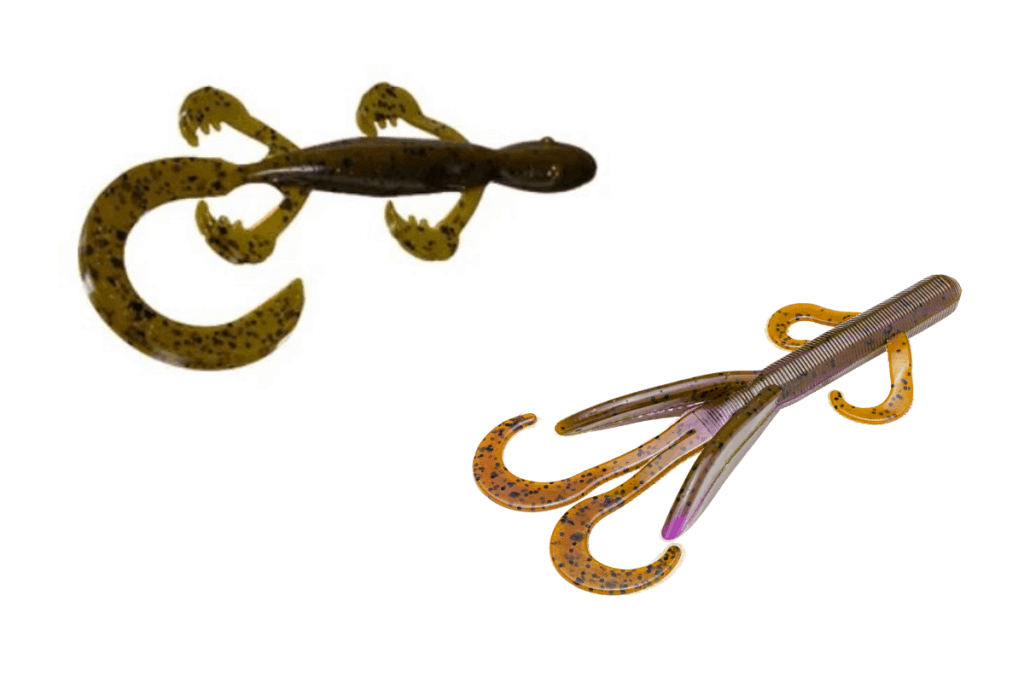
Carolina Rig
This setup has been a post-spawn staple for decades.
Like the crankbait, it can cover a vast amount of water and targets the depths with ease.
While not a true reaction bite, the heavy weight clacking along the bottom piques the interest of the curious bass. When the soft plastic lure comes scooting by them, it is often more than they can handle and will swallow it up.
The Carolina Rig is best utilized in waters with a rocky, sandy, or solid bottom. If there is too much vegetation, the rig will not be as effective.
There are a variety of lures that can be used on a Carolina Rig with great success. The most popular spring offering during the post-spawn is a lizard.
Another favorite is a creature bait of some sort.
Both lures have multiple appendages that create lots of action as it is dragged along the bottom.
Bladed Jig
Within the last decade, the bladed jig, or “Chatterbait” style lure, has been another go-to choice for anglers fishing the post-spawn.
Like the crankbait and Carolina Rig, a bladed jig can cover water and offers an intense vibration that alerts bass to its presence. This is especially effective if the water has some stain to it. If the water is dirty, a bladed jig quickly becomes an excellent choice.
Many anglers use a straight chunk-and-wind retrieve and it works.
I think a more effective method is to fish it like you would when bottom hopping a normal jig.
Let the lure sink to the bottom, hop it, or pull it up a couple of feet to let the blade chatter and then let it fall again.
Fishing the bladed jig in this manner tends to get bigger bites and is not quite as intense. If the bass are smashing it on a straight retrieve then keep doing that, but if not, be sure to hop it along the bottom and the more sluggish fish will respond better to it.
Other Searching Lures
The key is to locate fish. If you have a lure that you prefer to use that can cover water and has a more horizontal presentation, it likely will be a good post-spawn offering.
Lures like swim jigs, spinnerbaits, and topwaters can all be dynamite choices.
Keep Several Rods at Hand
The post-spawn is a time to have multiple rods and lures rigged and ready.
Attacking possible holding areas with multiple lures is an effective way to dial in exactly what is going to find bass.
Post-spawn fish may use different parts of the water column. Som will stay near the surface around docks and brush while others may hug the bottom in those same locations. There are even times when some will suspend part way down. This is quite common in areas with lots of docks. Those bass will sometimes hold halfway down on a dock piling.
Keeping several lure choices that cover water at hand is a great way to figure things out quicker. If you have another angler in the boat, be sure to use different search baits until a pattern is developed.
Once You Locate Bass
When post-spawn bass are found there may be better lure choices to work through the school.
Texas-rigged soft plastics and jigs are solid offerings that can pick through an area. If the school is nestled up in some sort of thick cover, like a brushpile or vegetation, these lures are efficient and effective.
Water Clarity
The amount of stain or color in the water can play a vital role in determining how deep the bass are going to get.
In lakes and rivers with ultra-clear water, the bass will hit the depths quicker than in stained water. If there is a lot of color in the location you are fishing, those post-spawn migration routes will be shallow all the way to the summer hangouts.
For those that live near large impoundments, finding water clarity that suits personal fishing style is a wonderful option. Running up-river for stained water suits shallow water anglers.
For those that prefer deep water tactics, heading towards the dam is the best choice to find clear water.
Running a Pattern
During the post-spawn, it is likely that an angler finds a pattern. If you find bass holding on the third secondary point in one cove it is very likely that the next cove over will find bass in the same area.
This works when fishing the same general part of a large lake or reservoir.
Bass that are way up a creek or river arm will be in a different phase of the spawn than those down by the dam.
That pattern may change from one day to the next or even with the same day as the weather changes, but post-spawners definitely will be in a similar phase within the same part of the lake.
Bluegill and Shad Spawn
These two species spawn right after the bass and are a key forage for post-spawn fish recuperating.
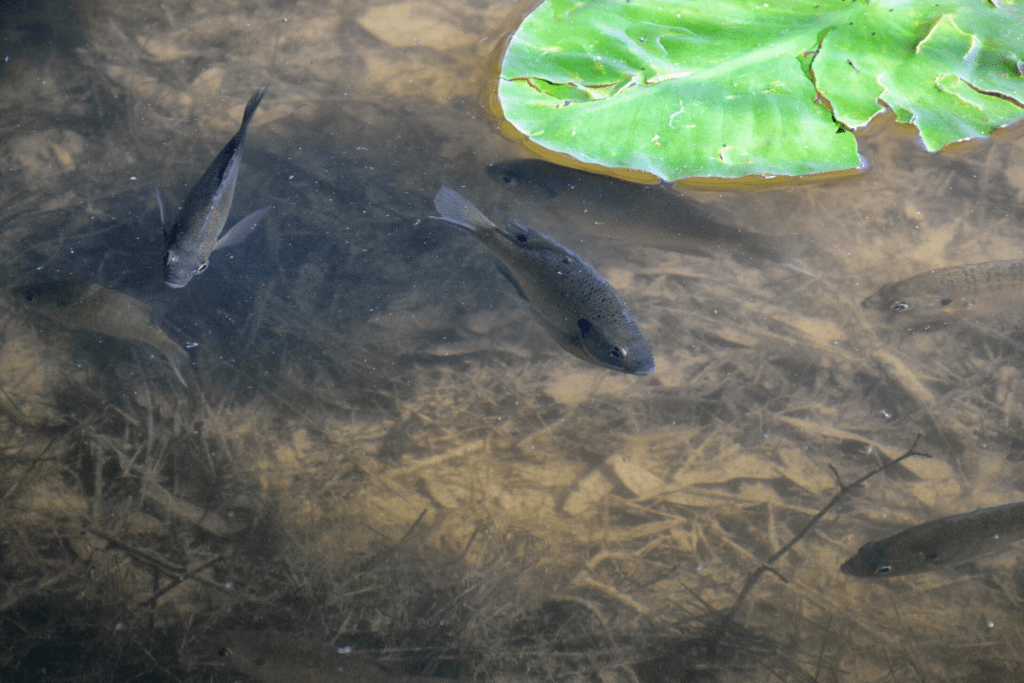
Bluegill
Sunfish will often spawn in the exact same areas the bass did. They will fan out beds and often spawn in huge groups.
If this happens right after the bass spawn, it will hold those post-spawn fish nearby for a longer period of time.
Bass may not always be seen up on the bluegill beds because they will often raid them in low light periods and overnight.
You can bet they will be nearby though. Fishing the area that drops into deeper water with bluegill imitating lures can be the recipe for a dynamite post-spawn bite.
Tubes, swim jigs, and burning squarebills are great choices for catching hungry bass hanging near bluegill beds.
Use colors that match the sunfish, especially in clear water.
Bluegills also tend to more actively spawn during the middle of the day. When the sun is high in the sky and beating down is a great time to probe the bluegill spawning beds.
Shad
The shad spawn can be unbelievable action for anglers that hit the lake before the sun gets up.
Shad prefer to spawn in rocky areas like along rip-rap or a rocky point. These baitfish will be shallow and easy picking during periods of low light. Cloudy and overcast days will hold the shad shallow a bit longer as will a solid weedline near the rocky structure.
Bass will push the shad ultra-shallow in an attempt to pin them against the shoreline. Lures need to be presented in those exact areas when the bite is on or the bass may ignore a bait that is four feet off the bank.
Work fast to find where the shad are spawning. Look for fish flicking the surface and a commotion.
Even though the bass are there to feed, you still need to make your lure look like an easy meal. Twitching, starting-and-stopping, or random movements will trigger strikes because the lure looks like an injured shad.
Color choices need to mimic the baitfish closely since that is what the bass are there for.
Post-spawn bass will find the shad spawn often farther along the migration routes. Rocky main lake points and secondary points are key locations.
Keep the lure in the strike zone as long as possible. Paralleling the shoreline is a terrific option when looking for bass actively feeding on spawning shad.
Final Thoughts
The post-spawn is a strange mix of fishing thoroughly, yet covering a lot of water. Keep the following in mind and the odds are that some schools of bass leaving the beds will be willing to come out and play.
- Find Migration Routes Between Spawning Flats and Summer Locations
- Bass Will Start to School Up Again
- Look for Bass Guarding Fry
- Use Lures That Can Cover Water
- Keep Several Rods Rigged Up
- Find the Water Clarity You Prefer
- Look For a Pattern
- Look for Bluegill and Shad Spawns
The post-spawn sometimes sounds more daunting than it is. It is a time when schools of fish can be found and caught on a variety of lures.
Exciting moments can be had while bluegill and shad spawn and anglers that prefer topwater bites are going to enjoy using them this time of year.
Once fish are found, work the area over and try to replicate that in other parts of the lake or river.
Tight lines. Be safe and don’t forget to encourage someone today. You never know how you may change their life forever.
Isaiah 6:8

